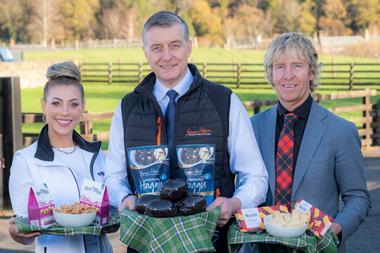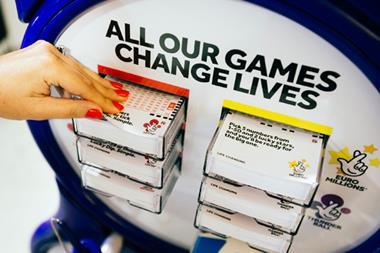The industry might still be assessing the merits of Tesco TV, but away from the fmcg sector it is attracting new money in an area with undreamt-of possibilities. Siân Harrington tunes in
Mrs Myers fudge shop, Barry’s Plumbing, National Express coaches, the Post Office and the Tunisian Tourist Board… add JR Hartley and you could be flicking through a copy of the Yellow Pages directory. But the above are all examples of the types of company using a much more unusual place to advertise their services - in their local Tesco café.
While the food and drink industry has been endlessly debating whether Tesco TV, the retailer’s in-store digital network, can really deliver value for money and results, those outside the fmcg world have been quick to realise the potential opportunity.
“At the moment this medium is attracting new money,” says Bill Pennell, Tesco media manager. “Advertisements range from the opening of a new DFS store to Central Office of Information messages. We have proposals out to 12 major car brands. It gives them a new audience and at the end of the ad it can say ‘By the way you can get this at your local dealership round the corner’.”
Tesco has appointed Lancashire-based WRT Group to sell local media on a national basis. The company is offering two-year packages, which are viewed every 30 minutes in the café. There are 14 categories and each ad is based on a template. So a dentist, for example, would send in copy and photos, the ad would be designed and then he would sign it off.
WRT has 1,500 slots to sell to local businesses and the rate card has been pitched at about £500 a year.
“When I got into this area I never dreamt of all these ideas,” says Pennell.
It is nearly two years since Tesco announced it was launching Tesco TV, one of a number of new revenue-generating ideas designed to position the retailer as a media owner. Since then supermarket competitors and retailers outside the sector have explored the idea but, with first-mover advantage, Tesco is still ahead of the game in terms of scale.
While there have been some delays in getting screens delivered, the network reaches six million people through 100 stores and by May will be in 300 stores, reaching 12 million customers.
But it has not been easy. Despite a plethora of positive headlines at launch, persuading advertisers to try the medium has been harder than expected. This has been compounded by the fact that Tesco is clear that it wants to separate in-store media from the traditional point-of-purchase advertising that forms part of the commercial deal between buyer and national account manager. As such, it is seeking a share of the marketing spend that goes to other media, including the public television networks. This means convincing not only brand owners but media buyers and planners at advertising agencies.
Pennell says: “This new media takes agencies out of their comfort zone and they will need to change their mindset.”
Indeed, the experience to date is that brand manufacturers rather than agencies are driving trial. This means that, contrary to plan, fmcg money has so far come from the national account managers.
“It’s a short-term gain to establish and convince,” says Pennell, who adds that the medium is attracting a 50/50 split between traditional trade expenditure and new money from non-fmcg companies.
“Brands are grasping the concept but there is still education to be done with agencies,” says Pennell. “But because it is ticking all the boxes for brands, they are going back to their agencies and telling them to use it.”
While the lack of understanding about Tesco TV clearly exasperates Pennell, the success of the other media opportunities convinces him the strategy is right. The six and eight-sheet poster ads, for example, are sold out for the next six months and Tesco has trebled its estate to 3,000 panels. Success stories like this have persuaded Pennell to start publicly advocating Tesco media. “Last year was about building opportunities with third parties to sell our media. Now we have built them, it is all about spreading the word, educating and selling. We need to communicate the win for the brand,” he says.
For this reason the company has brought all its media opportunities together under Tesco Media Services (The Grocer September 18, p10). This is designed to make it easier for suppliers to plan and execute campaigns. “We can help negotiate volume deals across our media as well as give advice and offer accountability,” says Pennell.
This accountability is key to advertisers and has been one of the criticisms of Tesco TV in particular. Pennell concedes that lessons have been learned but he is adamant that those who have tested out the medium have benefited.
“Even when brands are running a 10-second fluffy ad with a pack reveal in the first three seconds they have a 4% uplift in sales. When they support it with an offer or price promotion they have more than 10%,” Pennell says, adding that the key is getting that pack reveal at the start of the ad.
To those who say there is insufficient evidence to prove Tesco TV is solely responsible for the uplift, Pennell retorts: “We have done tests where the only difference is in-store TV. For example, Kellogg’s had 3% growth from a promotion but in stores with Tesco TV it was double that rate at 6%.”
He adds that in the past two months 74% of the fmcg products advertised on Tesco TV have seen a positive uplift (see box bottom left) and argues that there are mitigating factors for those that have not.
These factors include a cut-down end frame from a TV ad or an ad supplied without sound, competitor price activity or the end of a promotion.
The need to convince suppliers about the benefits of in-store screen advertising has pushed research up the agenda. IRI has been employed to run data four weeks before a campaign as well as after.
Tesco also ran a consumer survey of 1,000 people in Birmingham last month. “The results tell us that we must not show advertisements that appear on mainstream television. We also found out that there was a problem when advertising failed to appear in the relevant area in store and that customers want to see an advertisement only once,” says Pennell.
The content of an ad should last no longer than 10 seconds in the power aisle, where there are plenty of offers, and 20 seconds in health and beauty.
“The research showed that the customer is up for it if it helps. At worse they will ignore it,” says Pennell.
Ads with educational content are a big success, for example showing how to make a Martini in the beers, wines and spirits aisle.
L’Oréal will be using Tesco TV to teach customers about hair colourants in the run-up to Christmas while a recent Barbara Daly campaign showed customers how to apply make-up.
As fmcg brands continue their own research into Tesco TV’s effectiveness, Pennell and his team are finding new ways to exploit the media.
Home entertainment has been one of the most fruitful categories and Tesco is working with both film studios and book publishers on teaser campaigns for new releases.
Another avenue is sponsorship. As the result of a deal with The Press Association, live news is broadcast every half hour and weather is up for sponsorship
The industry as a whole may still be assessing Tesco TV but Pennell is confident the service will pay its way.
As he says: “We earn all our money from lots of £20,000 decisions rather than one big £1m campaign.”
What shoppers say
>> Tips for a successful campaign
Following consumer research into what works on Tesco TV, the retailer's advice is:
Do not show advertisements that appear on mainstream TV
Ensure advertisements appear in the relevant area in the store
Customers only want to see one ad once
Content should be shown for no longer than 10 sseconds on a screen placed in promotional aisles and for 20 seconds on screens in aisles such as health and beauty
Educational content works, for example, how to apply make-up or how to mix a cocktail
Tesco TV results
>> How exposure increased sales
In the past eight weeks 51 fmcg products have advertised on Tesco TV
16% had a sales uplift of more than 15%
10% grew between 10%-14%
24% grew between 5-9%
24& grew between 0-4%
26% failed to increase sales
Mrs Myers fudge shop, Barry’s Plumbing, National Express coaches, the Post Office and the Tunisian Tourist Board… add JR Hartley and you could be flicking through a copy of the Yellow Pages directory. But the above are all examples of the types of company using a much more unusual place to advertise their services - in their local Tesco café.
While the food and drink industry has been endlessly debating whether Tesco TV, the retailer’s in-store digital network, can really deliver value for money and results, those outside the fmcg world have been quick to realise the potential opportunity.
“At the moment this medium is attracting new money,” says Bill Pennell, Tesco media manager. “Advertisements range from the opening of a new DFS store to Central Office of Information messages. We have proposals out to 12 major car brands. It gives them a new audience and at the end of the ad it can say ‘By the way you can get this at your local dealership round the corner’.”
Tesco has appointed Lancashire-based WRT Group to sell local media on a national basis. The company is offering two-year packages, which are viewed every 30 minutes in the café. There are 14 categories and each ad is based on a template. So a dentist, for example, would send in copy and photos, the ad would be designed and then he would sign it off.
WRT has 1,500 slots to sell to local businesses and the rate card has been pitched at about £500 a year.
“When I got into this area I never dreamt of all these ideas,” says Pennell.
It is nearly two years since Tesco announced it was launching Tesco TV, one of a number of new revenue-generating ideas designed to position the retailer as a media owner. Since then supermarket competitors and retailers outside the sector have explored the idea but, with first-mover advantage, Tesco is still ahead of the game in terms of scale.
While there have been some delays in getting screens delivered, the network reaches six million people through 100 stores and by May will be in 300 stores, reaching 12 million customers.
But it has not been easy. Despite a plethora of positive headlines at launch, persuading advertisers to try the medium has been harder than expected. This has been compounded by the fact that Tesco is clear that it wants to separate in-store media from the traditional point-of-purchase advertising that forms part of the commercial deal between buyer and national account manager. As such, it is seeking a share of the marketing spend that goes to other media, including the public television networks. This means convincing not only brand owners but media buyers and planners at advertising agencies.
Pennell says: “This new media takes agencies out of their comfort zone and they will need to change their mindset.”
Indeed, the experience to date is that brand manufacturers rather than agencies are driving trial. This means that, contrary to plan, fmcg money has so far come from the national account managers.
“It’s a short-term gain to establish and convince,” says Pennell, who adds that the medium is attracting a 50/50 split between traditional trade expenditure and new money from non-fmcg companies.
“Brands are grasping the concept but there is still education to be done with agencies,” says Pennell. “But because it is ticking all the boxes for brands, they are going back to their agencies and telling them to use it.”
While the lack of understanding about Tesco TV clearly exasperates Pennell, the success of the other media opportunities convinces him the strategy is right. The six and eight-sheet poster ads, for example, are sold out for the next six months and Tesco has trebled its estate to 3,000 panels. Success stories like this have persuaded Pennell to start publicly advocating Tesco media. “Last year was about building opportunities with third parties to sell our media. Now we have built them, it is all about spreading the word, educating and selling. We need to communicate the win for the brand,” he says.
For this reason the company has brought all its media opportunities together under Tesco Media Services (The Grocer September 18, p10). This is designed to make it easier for suppliers to plan and execute campaigns. “We can help negotiate volume deals across our media as well as give advice and offer accountability,” says Pennell.
This accountability is key to advertisers and has been one of the criticisms of Tesco TV in particular. Pennell concedes that lessons have been learned but he is adamant that those who have tested out the medium have benefited.
“Even when brands are running a 10-second fluffy ad with a pack reveal in the first three seconds they have a 4% uplift in sales. When they support it with an offer or price promotion they have more than 10%,” Pennell says, adding that the key is getting that pack reveal at the start of the ad.
To those who say there is insufficient evidence to prove Tesco TV is solely responsible for the uplift, Pennell retorts: “We have done tests where the only difference is in-store TV. For example, Kellogg’s had 3% growth from a promotion but in stores with Tesco TV it was double that rate at 6%.”
He adds that in the past two months 74% of the fmcg products advertised on Tesco TV have seen a positive uplift (see box bottom left) and argues that there are mitigating factors for those that have not.
These factors include a cut-down end frame from a TV ad or an ad supplied without sound, competitor price activity or the end of a promotion.
The need to convince suppliers about the benefits of in-store screen advertising has pushed research up the agenda. IRI has been employed to run data four weeks before a campaign as well as after.
Tesco also ran a consumer survey of 1,000 people in Birmingham last month. “The results tell us that we must not show advertisements that appear on mainstream television. We also found out that there was a problem when advertising failed to appear in the relevant area in store and that customers want to see an advertisement only once,” says Pennell.
The content of an ad should last no longer than 10 seconds in the power aisle, where there are plenty of offers, and 20 seconds in health and beauty.
“The research showed that the customer is up for it if it helps. At worse they will ignore it,” says Pennell.
Ads with educational content are a big success, for example showing how to make a Martini in the beers, wines and spirits aisle.
L’Oréal will be using Tesco TV to teach customers about hair colourants in the run-up to Christmas while a recent Barbara Daly campaign showed customers how to apply make-up.
As fmcg brands continue their own research into Tesco TV’s effectiveness, Pennell and his team are finding new ways to exploit the media.
Home entertainment has been one of the most fruitful categories and Tesco is working with both film studios and book publishers on teaser campaigns for new releases.
Another avenue is sponsorship. As the result of a deal with The Press Association, live news is broadcast every half hour and weather is up for sponsorship
The industry as a whole may still be assessing Tesco TV but Pennell is confident the service will pay its way.
As he says: “We earn all our money from lots of £20,000 decisions rather than one big £1m campaign.”
What shoppers say
>> Tips for a successful campaign
Following consumer research into what works on Tesco TV, the retailer's advice is:
Do not show advertisements that appear on mainstream TV
Ensure advertisements appear in the relevant area in the store
Customers only want to see one ad once
Content should be shown for no longer than 10 sseconds on a screen placed in promotional aisles and for 20 seconds on screens in aisles such as health and beauty
Educational content works, for example, how to apply make-up or how to mix a cocktail
Tesco TV results
>> How exposure increased sales
In the past eight weeks 51 fmcg products have advertised on Tesco TV
16% had a sales uplift of more than 15%
10% grew between 10%-14%
24% grew between 5-9%
24& grew between 0-4%
26% failed to increase sales
















No comments yet